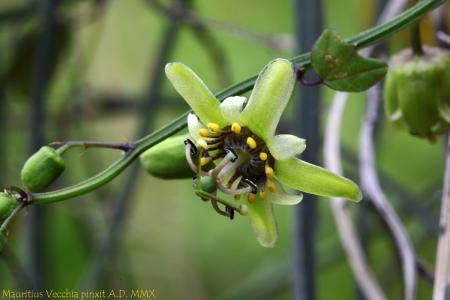
SUBGENUS: decaloba
SUPERSECTION: decaloba
SECTION: decaloba
GEOGRAPHICAL DISTRIBUTION OR ORIGIN:
Guatemala.
MINIMUM TEMPERATURE: 6°C
IDEAL MINIMUM TEMPERATURE: 10°C
ETYMOLOGY: From the Greek ἀλλᾶς, -ᾶντος allás, -ántos sausage, salami and φύλλον phýllon leaf: with sausage-shaped leaves.
DESCRIPTION:
Originally from the mountains of Guatemala, it stands out in particular for the unusual shape of the leaves. Its flowering, in fact, is not as striking as that of other species, since its flowers are very small. The whole plant is still pleasant and deserves to be grown as an unusual plant. It shows vivacity in growth and a spirit of adaptation, while not resisting below 6-7°C for long periods in winter.
Its cultivation in pots is possible anywhere and, with the exception of the hottest areas of Italy, should be sheltered during the cold season with appropriate protection.
It is a small climber with thin, shiny and hairless stems. The leaves are bilobed, sometimes with a slight hint of a third central lobe. They have a bizarre shape, as they are much wider than they are tall and sometimes appear to be transversely cropped. They have two series of leaf glands arranged symmetrically to the right and left of the median nervation. If there is plenty of light and the plant is watered and fertilised with care, the leaves can exceed 5 cm in width and 2.5 cm in length and take reddish colours, especially on the reverse side.
The flowers, about 1 cm in diameter, have white petals and sepals with a barely hinted green shade. They contrast with the crown of the filaments, which are simple and of an intense brown colour, with very dark amaranth shades. The tips of the filaments are instead of a beautiful bright yellow. The fruits are small brown berries.
P. allantophylla lends itself to being cultivated in pots even of modest size, which facilitates its winter recovery at home or in a sheltered and warm place. The appearance of the plant in full vegetation is pleasant for the aesthetics of the leaves which tend to be arranged regularly in an imbricated position.
A rich and drained soil should be ensured to enhance its discreet beauty to the maximum and see it grow with vivacity and in full health.
It multiplies without problems by seed or
by cutting.